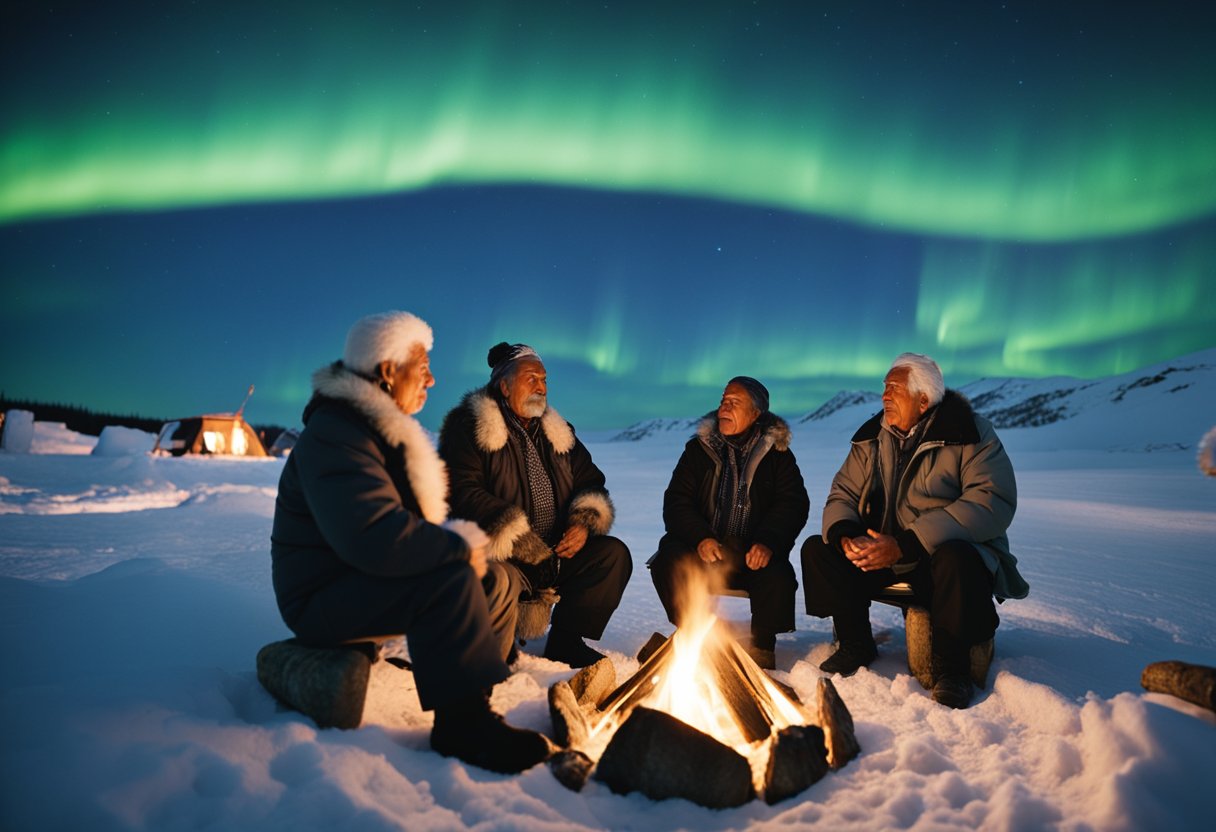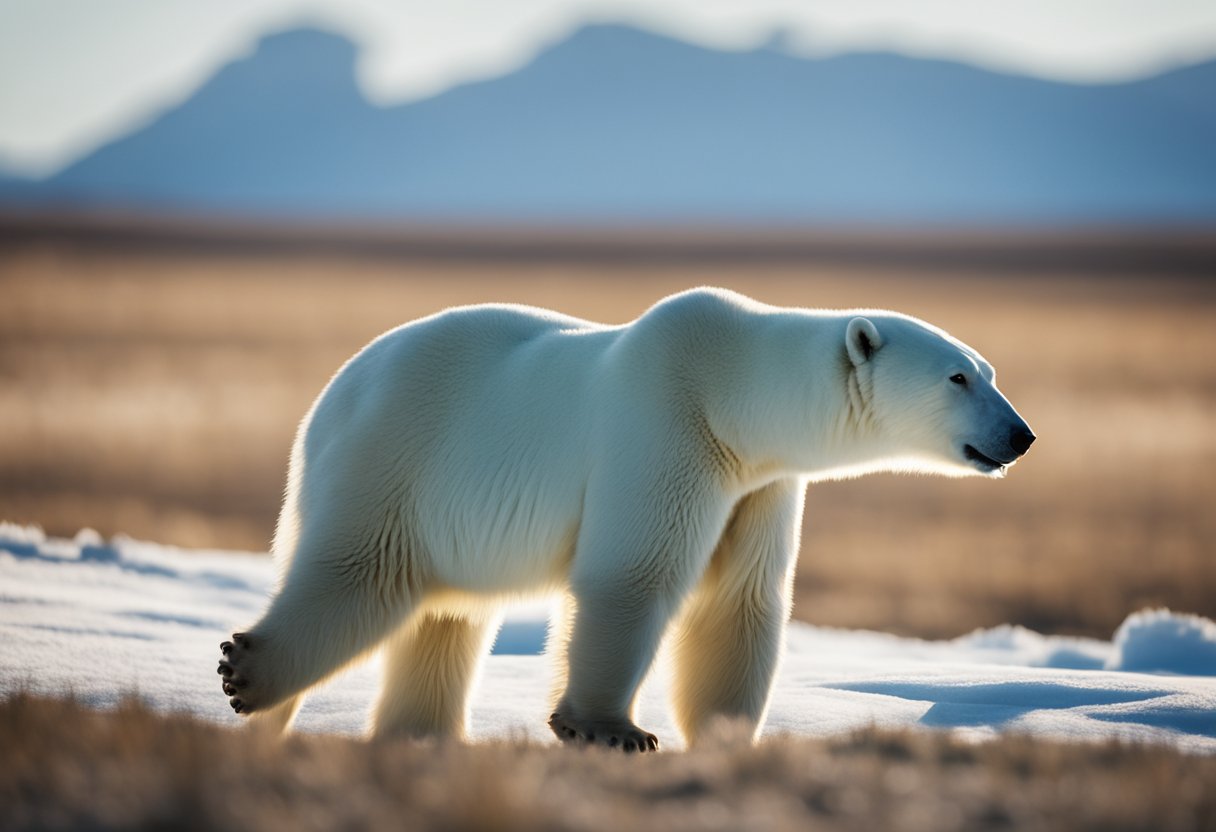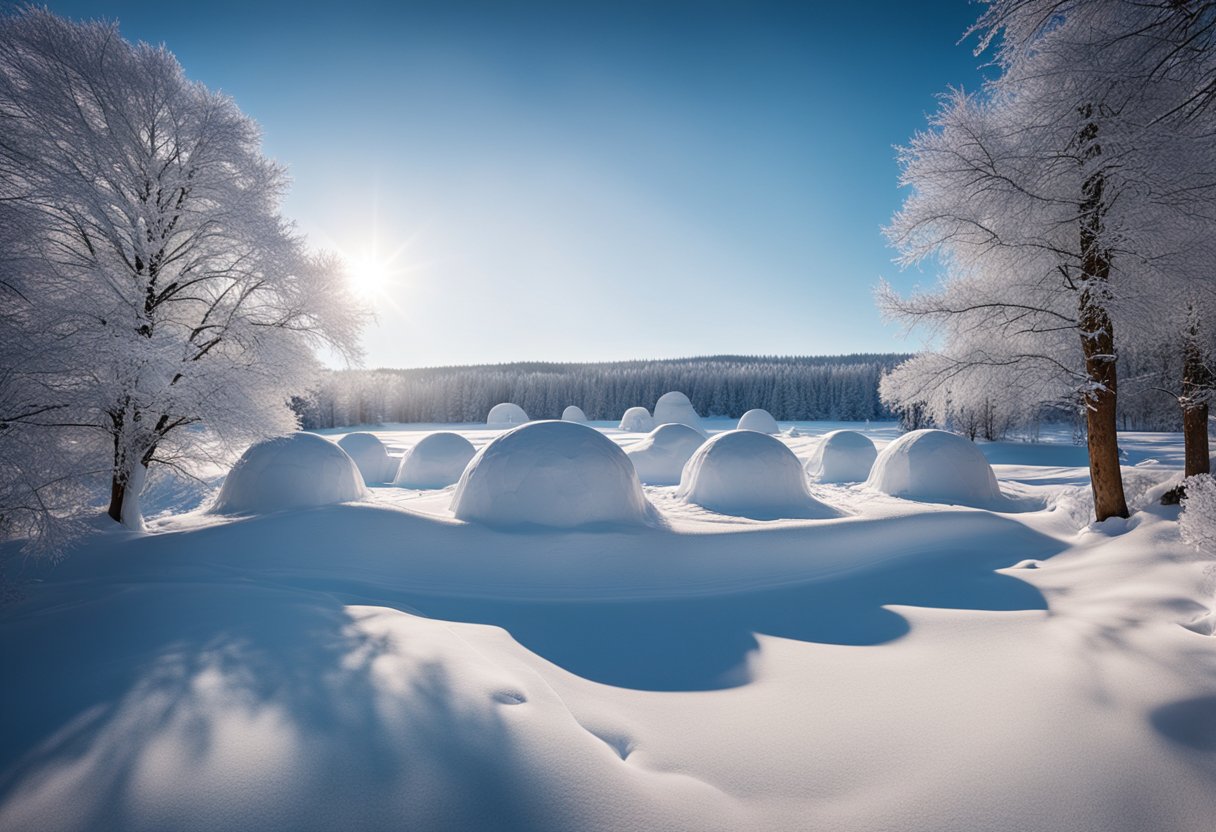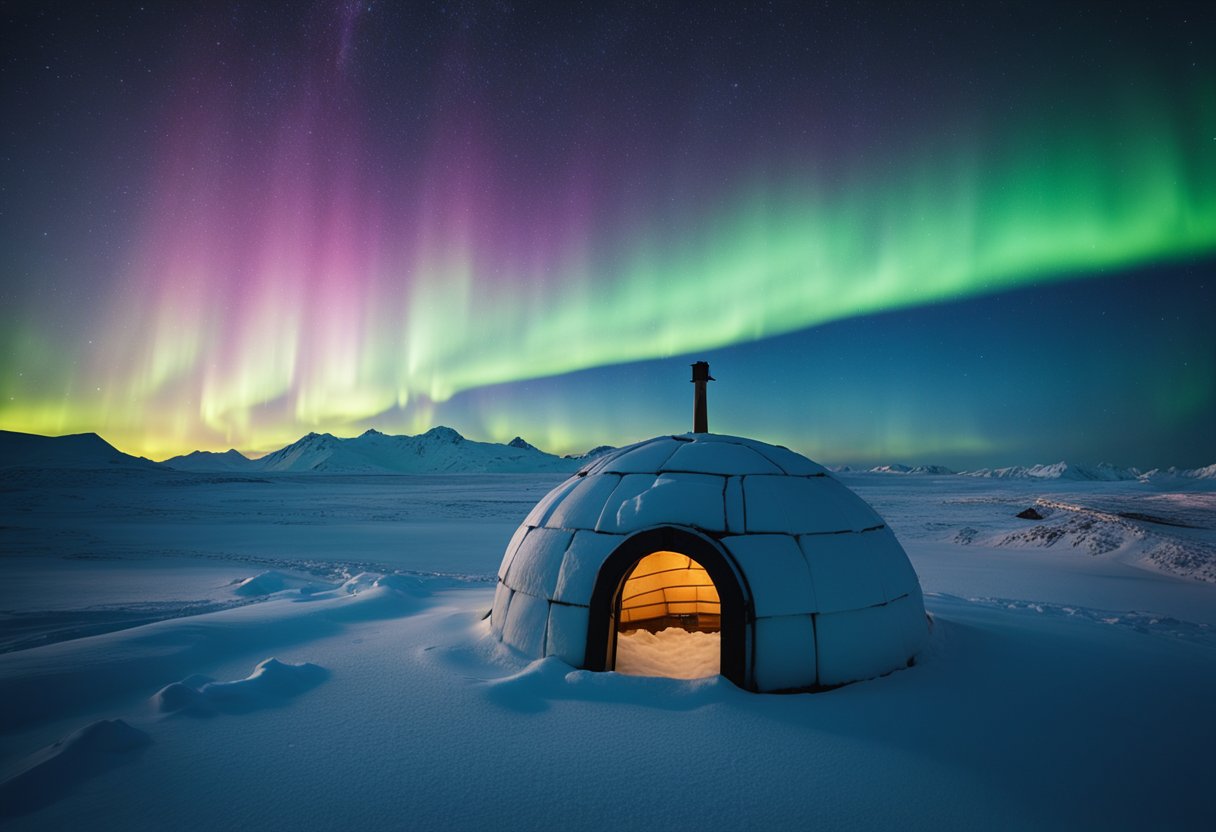The Inuit Way: Unveiling Traditions and Myths of the Arctic Circle

Updated On: April 22, 2024 by Eman Sameh
In the heart of the Arctic Circle, the Inuit peoples sustain a way of life that weds ancient customs to contemporary practices. This rich cultural fabric has seen generations adapt to one of the planet’s most unforgiving environments. The Inuit, who inhabit regions spanning from Greenland through Northern Canada to parts of Alaska, share a linguistic and cultural lineage that reveals itself in a myriad of ways, from their stories and spirituality to their art and societal structures.

Understanding the Inuit way of life sheds light on their complex societal structures, indigenous livelihoods and the adaptation to harsh Arctic conditions. Amidst frigid temperatures and ice-laden landscapes, the Inuit have cultivated a resilient culture that hinges on a profound connection with their environment. Through their myths and legends, they convey wisdom and values, while arts and music serve as expressions of a richly storied heritage.
The Inuit People: Origins and Demographics

The Inuit are an Indigenous people with a rich cultural history, inhabiting regions across Canada, Greenland, and Alaska. Our exploration here is focused on their origins and present-day demographics.
Historical Perspective
Origins: The Inuit have roots tracing back to the Thule people, who are thought to have migrated from the Bering Strait around 1000 CE. This migration led to the spread of their population across the Arctic. They are linguistically and culturally distinct from other Indigenous groups such as the Yupik and the Aleut with whom they share ancestral ties.
Cultural Identity: Historically, the Inuit have been commonly associated with the term “Eskimo”. However, this term is considered outdated and sometimes disrespectful. The term ‘Inuit’, meaning ‘people’, is used today and their language is called Inuktitut. Their traditional culture is intimately connected with the Arctic environment.
Population Distribution
Canada: The majority of Inuit reside in the northern regions of Canada, within an area known as Inuit Nunangat. This encompasses four regions: Nunatsiavut (Labrador), Nunavik (Northern Quebec), Nunavut, and the Inuvialuit Region of the Northwest Territories.
| Region | Estimated Inuit Population |
|---|---|
| Nunatsiavut | 2,500 |
| Nunavik | 12,000 |
| Nunavut | 35,000 |
| Inuvialuit Region | 3,200 |
Greenland: Greenland’s population is predominantly Inuit, with around 50,000 residing there. They are locally known as Kalaallit and they enjoy a self-governed status within the Kingdom of Denmark.
Alaska: In Alaska, several Inuit and closely related Iñupiat and Yupik communities can be found, especially in the northern and southwestern parts. An estimated 16,000 Inuit live in Alaska.
Population tracking and census data provide us information crucial for understanding the current state of Inuit peoples, underscoring the importance of indigenous culture in the subarctic and Arctic regions. Our exploration sheds light on the contemporary dynamics of the Inuit populations, central to the heritage and future of the regions they inhabit.
Cultural Pillars of the Inuit Way
In the heart of the Arctic Circle, the Inuit community maintains a culture that is deeply rooted in traditions and spirituality. It is sustained by the transmission of knowledge and beliefs through various forms of artistic expression and oral narratives.
Traditions and Oral Tradition
Inuit traditions are the bedrock of their society with elders playing a vital role in passing down customs and knowledge. The wisdom of the elders is conveyed through stories that have been preserved over centuries. Central to these is the practice of oral traditions, where history and lessons are shared through narratives, often accompanied by song and dance. This ensures the survival of their rich heritage despite the harshness of the ice-clad environment.
- Songs & Dances: Instruments like the qilaut (drum) are used in rituals and celebrations.
- Storytelling Sessions: Take place at family and community gatherings.
Arts and Storytelling
Inuit art is another cultural pillar, manifesting in intricate carvings and beautiful pieces depicting Arctic life. Storytelling is intertwined with artistic expression, serving both a practical purpose in recording history and a creative one in capturing the imagination with tales of mythology and legends.
- Carvings: Often use materials such as soapstone, bone, and ivory.
- Narratives: Weave together animal, human, and supernatural realms.
Religious and Spiritual Beliefs
The spiritual and religious beliefs of the Inuit are closely linked to the natural world and reflect their reliance on and respect for the land. Shamans play a significant role in the community as guides and healers, with an intimate belief system centred around the balance between man and nature. Creation stories and practices reflect an oral tradition rich in symbolism and connection to the environment.
- Shamans: Act as intermediaries between the people and the spirit world.
- Creation Myths: Detailed narratives explain natural phenomena and the origin of life.
Environmental Adaptation and Housing
In the face of the Arctic Circle’s extreme conditions, the Inuit have developed remarkable survival strategies. Their traditional architecture and way of life are a testament to human resilience and ingenuity.
Adapting to the Arctic Circle
In the Arctic tundra, a land of ice and snow, surviving requires a deep understanding of the environment. The Inuit demonstrate a profound capacity for adaptation, having developed their way of life around the resources available in this challenging landscape. Survival in the Arctic Circle is about endurance and utilising the environment to one’s advantage. This entails understanding the land, from the frozen coast to the interior ice cap, and making use of natural materials for Inuit clothing, which is meticulously crafted to protect against the harsh climate.
Traditional Inuit Architecture
Traditional Inuit architecture reflects a harmonious blend of form and function, perfectly suited to the Arctic conditions. The quintessential Inuit dwelling, the igloo, is a marvel of design, with its blocks of snow laid out in a spiral pattern to create a stable, insulated shelter. Igloos were mainly used as temporary shelters for hunters on the ice. On the coast, where resources were more abundant, semi-permanent structures known as sod houses were common. Built with a framework of whalebone or driftwood covered by turf, these homes offered greater protection and warmth during long winters on the tundra.
Indigenous Livelihoods: Hunting and Gathering
For centuries, hunting and gathering have been vital for survival in the harsh Arctic environment. These practices are deeply interwoven with the cultural fabric of the Inuit people, forming the backbone of their livelihood and sustenance.
Methods and Tools for Hunting
When discussing the hunting techniques of the Arctic’s indigenous populations, we focus on the expert use of specific tools crafted from the land. Inuit hunters skilfully employ harpoons, bows, and spears made from materials such as bone, ivory, and wood; each implement is tailored for efficiency and resilience against the ice and tundra. The synergy of these methods and tools enables hunters to navigate and endure the unforgiving Arctic conditions in pursuit of game.
Sea Mammals and Fishing
Fishing and hunting sea mammals, like seals, are critical for the Inuit, not just for food but as a cornerstone of their culture. The ice plays a significant role as a platform from which to carry out these activities, with holes to access the teeming waters beneath. Traditional knowledge, passed down through generations, guides the Inuit in predicting seal behaviour and understanding the subtle dynamics of the marine environment.
Caribou and Reindeer
Pursuing caribou and reindeer represents an essential aspect of the Inuit’s terrestrial hunting practices. These animals are highly regarded for their meat and hides, which are integral to survival in freezing temperatures. The seasonal migration of caribou also dictates the movement and activities of the people, underscoring the deep bond between the land, its creatures, and the Inuit way of life.
Inuit Societal Structures

The Inuit social fabric is intricately woven with an emphasis on family and community relationships, guided by the wisdom of elders.
Family and Community
Family units are the fundamental component of Inuit society, often consisting of the nuclear family and extended relatives. Living arrangements traditionally include several families in clusters, sharing resources and responsibilities. This close-knit structure supports a collaborative way of life that is essential for survival in the harsh Arctic environment. Marriage practices vary, with polygamy being an accepted form, although not as common today.
The communal aspect extends to a village or region’s broader indigenous population. Here, lives intertwine, allowing for a network of mutual support, especially when it comes to hunting and sharing the ensuing bounties.
Influence of the Elders
Elders are pivotal in Inuit communities and revered for their knowledge and experience. They impart crucial survival skills, such as hunting techniques and an understanding of the land, and they are the custodians of oral histories and legends that underpin cultural identity.
From birth, Inuit children are integrated into this circle of wisdom, learning from their elders about the values and practices that have sustained their people for generations. Respect for their insight influences decision-making at both the familial and communal levels, ensuring that traditional ways endure alongside modern adaptations.
The principles of respect and tradition that govern these social structures are fundamental to the Inuit way of life, giving strength and continuity to their identity as indigenous peoples of the Arctic.
Challenges Facing the Inuit

As we explore the lives of the Inuit, we must acknowledge the serious challenges they face, particularly from the effects of climate change and cultural preservation against modern pressures. These issues threaten their traditional way of life and their delicate Arctic environment.
Climate Change Effects
Climate change is profoundly affecting the Arctic, leading to diminishing sea ice and altered wildlife patterns. This directly impacts the Inuit, for whom hunting seals and whales is a subsistence and cultural cornerstone. The thinning ice also poses safety risks for those traversing traditionally known paths and increases the susceptibility of coastal villages to erosion and storms.
Modern technology offers some aid, such as improved communication for safety and weather forecasting, but it doesn’t negate the fundamental changes to the Inuit’s deeply intertwined relationship with their environment. International and indigenous programs aim to address these challenges, seeking to preserve the Arctic and its residents.
Cultural Preservation Against Modern Pressures
The Inuit’s rich culture—comprising language, art, and communal traditions—is experiencing an onslaught of modern pressures. The allure of urban living can draw the younger generations away from their communities, leading to a potential decline in cultural practices.
Efforts are being made to maintain cultural sovereignty through educational programmes that focus on teaching Inuktitut and traditional skills. Indigenous groups are instrumental in these undertakings, ensuring a balance between embracing beneficial modern technology and conserving their time-honoured way of life. The interaction between global interest and the desire of the Inuit to manage modern technology reflects the nuanced reality of cultural preservation.
The Role of Inuit in International Contexts

In the complex tapestry of international relations and global movements, the Inuit have carved out a role that underscores their resilience and strategic diplomacy. Across the Arctic, their endeavours in asserting sovereignty and collaborating with states reflect their adaptability and strength.
Participation in Global Indigenous Movements
Through organisations like the Inuit Circumpolar Council (ICC), the Inuit actively participate in international indigenous movements. This collaboration underscores their agency in global fora, uniting Inuit voices from regions in Canada, Greenland—which is a self-governing division of Denmark—Alaska in the United States, and Chukotka in Russia. Through such coalitions, the Inuit influence policies affecting the Arctic and elevate their cultural and environmental objectives on the world stage.
Inuit Sovereignty and Relations with States
The quest for Inuit sovereignty is a tapestry woven with threads of both collaboration and self-determination. In territories like Greenland and within the bounds of the Canadian Arctic, the Inuit maintain a majority, which bolsters their political and cultural presence. They negotiate with states, including the United States, Denmark, and Russia, to protect their rights and advance their interests. This strategic engagement with nations is intricate but showcases the pivotal role the Inuit play in shaping Arctic governance and asserting their sovereignty.
Mythology and Spirituality in Inuit Culture
The Inuit culture is rich with spirituality and mythology, deeply entrenched within its oral tradition and storytelling. Nature is intricately woven into their beliefs, as are supernatural beings that encompass the essence of Inuit spirituality.
Creation Myths and Legends
Myths of creation within Inuit culture often centre on the figure of Sedna, the sea goddess. She is a pivotal character in Inuit mythology, believed to be the ruler of the sea and marine animals. According to legend, her fingers, once severed in a tragic tale of betrayal and loss, transformed into the various sea creatures that Inuit hunters depend on.
This story, passed down through generations, highlights the Inuit’s deep connection with nature and their respect for the animals they both revere and rely upon for survival. Additionally, the figure of Kiviuq, an eternal wanderer, features prominently in Inuit legends. His adventures, fraught with challenges from man, spirits, and animals, depict Arctic life’s harsh realities and spiritual dimensions.
Rituals and Shamanism
The shaman or angakkuq holds a special place in rituals and the practice of shamanism. They are intermediaries between the physical and spiritual realms, dealing with spirits, aiding in healing, and ensuring the community’s well-being. Through ceremonies and the use of drums, it is believed that shamans can travel to other worlds, communicate with spirits, and guide the souls of the deceased towards the afterlife.
The Qalupalik, creatures of legend, are said to inhabit the sea, taking those who do not heed the warnings of their elders. Their tales serve to foster listening and obedience in young people, embedding moral and practical values. The Tuniit, often described as a race of giants and credited with constructing certain stone structures in the Arctic, further illustrate the spiritual belief Inuit have regarding those who came before and the shadowy realms that exist alongside our own.
Arts, Music, and Cultural Expression

The rich traditions of the Inuit people are vividly expressed through their unique art forms and the vital role that music and dance play in their cultural events.
Inuit Art Forms
Inuit art deeply reflects cultural identity and the environment. It encompasses a variety of mediums, from intricate carvings sculpted from bone, ivory, and stone to drawings that capture the essence of the Arctic landscape and its inhabitants. Traditional illustrations often depict scenes of daily life, animals, and mythical figures, rich with stories passed down through generations.
The Importance of Song and Dance
For the Inuit, song and dance are more than entertainment; they’re essential threads in the fabric of community life. They perform katajjaq, or throat singing, where two individuals stand face-to-face, engaging in a vocal game that is as much a test of endurance as it is an art form. Dance, too, is a crucial aspect of cultural expression—a way to tell stories, commemorate events, and convey the values and beliefs of the Inuit people.
Language and Education

In the Arctic Circle, the Inuit people maintain a rich linguistic heritage and prioritise education that honours their traditions while embracing modern advancements.
Inuktitut and Linguistic Diversity
Inuktitut, an essential part of the Inuit heritage, boasts several dialects across the Arctic. This language is central to the identity of many indigenous peoples and is a subject of great pride. Efforts to preserve the use of Inuktitut are fundamental to maintaining the cultural fabric of Inuit communities. Educational programs focus on bilingual curricula, integrating Inuktitut with English or French, ensuring linguistic diversity and resilience.
- Number of Inuktitut speakers: Over 35,000 in Canada
- Written forms: Syllabics and Latin alphabet
- Efforts in linguistically diverse education include:
- Bilingual teaching materials
- Inuktitut language classes
Educational Programs and Knowledge Transmission
Our educational programs seek to blend traditional Inuit knowledge with contemporary academic curricula. By doing this, we ensure that the inheritance of oral traditions and rich narratives continues alongside subjects like mathematics and science. There is a strong emphasis on practical, experience-based learning, reflecting our community’s historical learning methods.
- Educational focus
- Incorporation of traditional Inuit knowledge in curricula
- Technological advancement to support remote education
- Key medium of knowledge transmission: Oral storytelling
Schools and community centres often become hubs for education in both Inuktitut and global languages, enabling the Inuit youth to navigate a progressively interconnected world while staying rooted in their unique cultural identity.
Contemporary Inuit Life and Globalization
In recent years, the Inuit have experienced significant cultural transformations due to the twin forces of modern technology and globalization.
Inuit Interaction with Modern Technology
We have witnessed how modern technology enhances Inuit life in the Arctic Circle. Utilising the internet, many Inuit communities can now communicate with the wider world, share their culture and learn from others. Satellite connectivity has improved access to services and information, while technologies like GPS have greatly aided traditional hunting practices. Integrating new technologies has allowed the Inuit to sustain their way of life and connect with global networks while maintaining a strong link to their cultural heritage.
Globalization and Media Representation
Globalization has affected the way the Inuit culture is represented in media. Films and television, often produced outside of the Inuit community, have begun depicting their stories and traditions to a global audience. However, this representation is double-edged; while it can raise awareness about the Inuit way of life, it can also lead to misinterpretation or oversimplification of their culture. Nonetheless, some Inuit have taken it upon themselves to engage with such media to ensure accurate and respectful representation, harnessing these global platforms to tell their own stories and confront issues like food security, as described in an article highlighting the impact of globalization and global warming on Inuit food security.
Frequently Asked Questions

This section addresses some of the most common inquiries regarding the Inuit way of life and their rich cultural tapestry, from traditional practices to myths illuminating the Arctic skies.
What are the core traditions and celebrations of the Inuit?
Our traditions are intimately tied to the rhythms of nature. Seasonal hunts and the subsistence lifestyle have shaped celebrations like the community feast known as ‘kivgiq’, which fosters unity and the sharing of resources. We mark the passage of the seasons and the success of hunts with ceremonies and storytelling, ensuring our cultural heritage is passed down through generations.
Which creatures are prominent in Inuit mythology?
Mythical beings in our stories embody the spirit of the Arctic environment. The Anirniq, for instance, is the vital life force present in all living beings, believed to be the spirit of breath. Sea creatures like the tusked narwhal are also significant, symbolising the mysterious depths of our oceanic lands.
How do Inuit myths explain the phenomenon of the northern lights?
Our ancestors perceived the northern lights, or aurora borealis, as more than just a natural spectacle. Myths depict them as the spirits of the deceased playing a celestial ball game with a walrus skull, reminding us of the connection between the land of the living and the world of the spirits.
Can you elaborate on Inuit creation stories, particularly involving the raven?
The raven plays a pivotal role in our creation stories. It is often considered a trickster but also a central figure in shaping the world. In some tales, the raven releases light into the world, transforming from a small bird into a charismatic creature responsible for carving out the complexities of our land and sea.
What are some defining facts of Inuit culture?
Inuit culture is defined by adaptability and resourcefulness, honed by the Arctic’s challenges. Our cultural identity is tightly interwoven with skills like igloo building, traditional clothing crafting, and the use of dog sleds. Values such as community, respect for elders, and deep knowledge of the environment are paramount.
In what ways has the geography of the Arctic influenced Inuit cultural practices?
The severe climate and geography have shaped almost every aspect of our lives, from our semi-nomadic movements following animal migrations to the use of specific tools designed for ice and snow conditions. Arctic living demands a profound respect for and understanding of our environment, which is evident in the sustainable practices we employ and the stories we tell about the land and its creatures.






